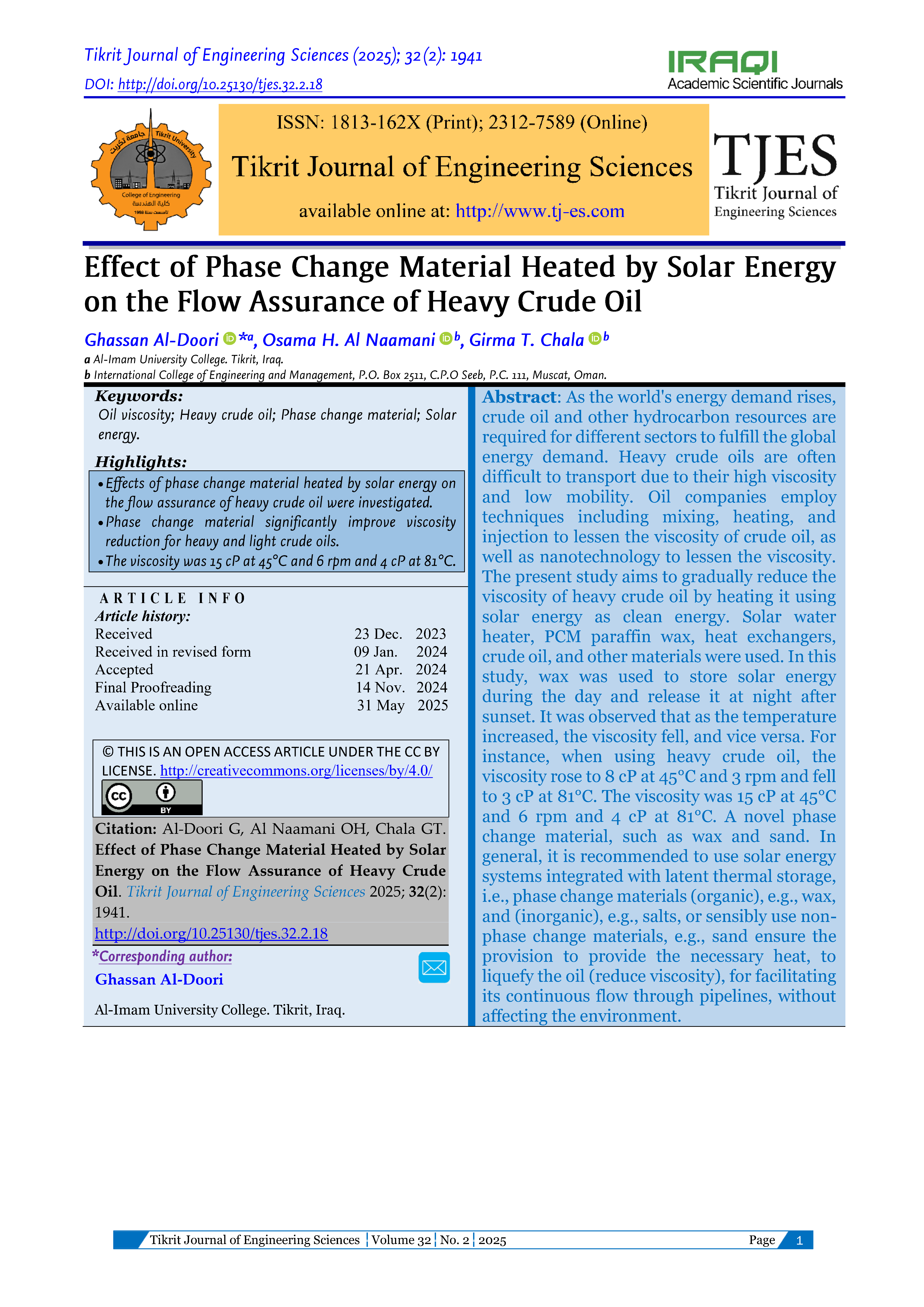Effect of Phase Change Material Heated by Solar Energy on the Flow Assurance of Heavy Crude Oil
Main Article Content
Abstract
As the world's energy demand rises, crude oil and other hydrocarbon resources are required for different sectors to fulfill the global energy demand. Heavy crude oils are often difficult to transport due to their high viscosity and low mobility. Oil companies employ techniques including mixing, heating, and injection to lessen the viscosity of crude oil, as well as nanotechnology to lessen the viscosity. The present study aims to gradually reduce the viscosity of heavy crude oil by heating it using solar energy as clean energy. Solar water heater, PCM paraffin wax, heat exchangers, crude oil, and other materials were used. In this study, wax was used to store solar energy during the day and release it at night after sunset. It was observed that as the temperature increased, the viscosity fell, and vice versa. For instance, when using heavy crude oil, the viscosity rose to 8 cP at 45°C and 3 rpm and fell to 3 cP at 81°C. The viscosity was 15 cP at 45°C and 6 rpm and 4 cP at 81°C. A novel phase change material, such as wax and sand. In general, it is recommended to use solar energy systems integrated with latent thermal storage, i.e., phase change materials (organic), e.g., wax, and (inorganic), e.g., salts, or sensibly use non-phase change materials, e.g., sand ensure the provision to provide the necessary heat, to liquefy the oil (reduce viscosity), for facilitating its continuous flow through pipelines, without affecting the environment.
Metrics
Article Details

This work is licensed under a Creative Commons Attribution 4.0 International License.
THIS IS AN OPEN ACCESS ARTICLE UNDER THE CC BY LICENSE http://creativecommons.org/licenses/by/4.0/
Plaudit
References
Kumar N, Gupta SK. Progress and Application of Phase Change Material in Solar Thermal Energy: An Overview. Materials Today: Proceedings 2021; 44:271–281. DOI: https://doi.org/10.1016/j.matpr.2020.09.465
Delgado JMPQ, Martinho JC, Sá AV, Guimarães AS, Abrantes V. Thermal Energy Storage with Phase Change Materials. Springer International Publishing; 2019. DOI: https://doi.org/10.1007/978-3-319-97499-6
Griffiths PW, Eames PC. Performance of Chilled Ceiling Panels Using Phase Change Material Slurries as the Heat Transport Medium. Applied Thermal Engineering 2007; 27(10):1756–1760. DOI: https://doi.org/10.1016/j.applthermaleng.2006.07.009
Kuznik F, Virgone J, Noel J. Optimization of a Phase Change Material Wallboard for Building Use. Applied Thermal Engineering 2008; 28(11–12):1291–1298. DOI: https://doi.org/10.1016/j.applthermaleng.2007.10.012
Sharma A, Tyagi VV, Chen CR, Buddhi D. Review on Thermal Energy Storage with Phase Change Materials and Applications. Renewable and Sustainable Energy Reviews 2009; 13(2):318–345. DOI: https://doi.org/10.1016/j.rser.2007.10.005
Setoh G, Tan FL, Fok SC. Experimental Studies on the Use of a Phase Change Material for Cooling Mobile Phones. International Communications in Heat and Mass Transfer 2010; 37(9):1403–1410. DOI: https://doi.org/10.1016/j.icheatmasstransfer.2010.07.013
Vakhshouri AR. Paraffin as Phase Change Material. Paraffin Overview 2020; 1–23.
AL-Ataby MJA. Phase Change Materials for Thermal Energy Storage. Journal of Petroleum Research and Studies 2012; 3(1): 69-92. DOI: https://doi.org/10.52716/jprs.v3i1.64
Xiao X, Zhang P, Li M. Experimental and Numerical Study of Heat Transfer Performance of Nitrate/Expanded Graphite Composite PCM for Solar Energy Storage. Energy Conversion and Management 2015; 105:272–284. DOI: https://doi.org/10.1016/j.enconman.2015.07.074
Du K, Calautit J, Wang Z, Wu Y, Liu H. A Review of the Applications of Phase Change Materials in Cooling, Heating and Power Generation in Different Temperature Ranges. Applied Energy 2018; 220:242–273. DOI: https://doi.org/10.1016/j.apenergy.2018.03.005
Mofijur M, Mahlia TMI, Silitonga AS, Ong HC, Silakhori M, Hasan MH, Rahman SA. Phase Change Materials (PCM) for Solar Energy Usages and Storage: An Overview. Energies 2019; 12(16):3167. DOI: https://doi.org/10.3390/en12163167
TK G, Raj V. Use of Phase Change Material (PCM) for the Improvement of Thermal Performance of Cold Storage. MOJ Current Research & Reviews 2018; 1(2):49–61. DOI: https://doi.org/10.15406/mojcrr.2018.01.00010
Rashid FL, Al-Obaidi MA, Dulaimi A, Mahmood DMN, Sopian K. A Review of Recent Improvements, Developments, and Effects of Using Phase-Change Materials in Buildings to Store Thermal Energy. Designs 2023; 7(4):90. DOI: https://doi.org/10.3390/designs7040090
Yaghi BM, Al-Bemani A. Heavy Crude Oil Viscosity Reduction for Pipeline Transportation. Energy Sources 2002; 24(2):93–102. DOI: https://doi.org/10.1080/00908310252774417
Chala GT, Sulaiman SA, Japper-Jaafar A. Flow Start-Up and Transportation of Waxy Crude Oil in Pipelines: A Review. Journal of Non-Newtonian Fluid Mechanics 2018; 251:69–87. DOI: https://doi.org/10.1016/j.jnnfm.2017.11.008
Hasan SW, Ghannam MT, Esmail N. Heavy Crude Oil Viscosity Reduction and Rheology for Pipeline Transportation. Fuel 2010; 89(5):1095–1100. DOI: https://doi.org/10.1016/j.fuel.2009.12.021
Huang Q, Li H, Zhuang Y, Ding Y, Ma C, Chen C, Zhang J. Reducing Viscosity of Waxy Crude Oil with Electric Field Perpendicular to Oil’s Flow Direction. Fuel 2021; 283:119345. DOI: https://doi.org/10.1016/j.fuel.2020.119345
Martínez-Palou R, de Lourdes Mosqueira M, Zapata-Rendón B, Mar-Juárez E, Bernal-Huicochea C, de la Cruz Clavel-López J, Aburto J. Transportation of Heavy and Extra-Heavy Crude Oil by Pipeline: A Review. Journal of Petroleum Science and Engineering 2011; 75(3–4):274–282. DOI: https://doi.org/10.1016/j.petrol.2010.11.020
Cavicchio CA, Biazussi JL, de Castro MS, Bannwart AC, Rodriguez OM, de Carvalho CH. Experimental Study of Viscosity Effects on Heavy Crude Oil-Water Core-Annular Flow Pattern. Experimental Thermal and Fluid Science 2018; 92:270–285. DOI: https://doi.org/10.1016/j.expthermflusci.2017.11.027
Homayuni F, Hamidi AA, Vatani A. An Experimental Investigation of Viscosity Reduction for Pipeline Transportation of Heavy and Extra-Heavy Crude Oils. Petroleum Science and Technology 2012; 30(18):1946–1952. DOI: https://doi.org/10.1080/10916461003681646
Tao R, Tang H. Reducing Viscosity of Paraffin Base Crude Oil with Electric Field for Oil Production and Transportation. Fuel 2014; 118:69–72. DOI: https://doi.org/10.1016/j.fuel.2013.10.056
Holman JP. Heat Transfer. McGraw-Hill; 2010.
Gilliland ER. Diffusion Coefficients in Gaseous Systems. Industrial & Engineering Chemistry 1934; 26(6):681–685. DOI: https://doi.org/10.1021/ie50294a020





